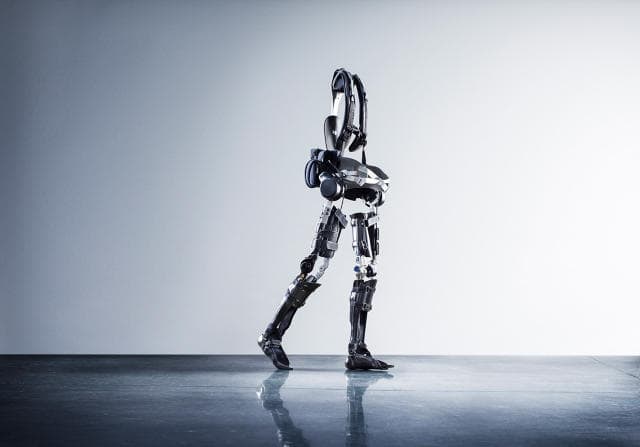iRobot-Like Exoskeleton Works Miracle For Paraplegics - Makes Walking Possible Again
SuitX is the VC and government backed company behind this exoskeleton that is set to change the lives of paraplegics for the better. Paraplegics are people with permanent paralysis of the legs caused by spinal injuries, and this exoskeleton has potential applications in industrial, medical and military markets. Based out of Berkeley California, SuitX, with its Phoenix robotic system, has not only brought life back into the disabled, but has done so at an affordable price of $40,000.

Most other exoskeleton projects by other companies had a wider audience and applications to cater to, and as a result, were quite heavy. SuitX has taken a minimalistic approach towards the exoskeleton by limiting itself to one goal only; helping paraplegics walk. The re-imagination led to an extremely lightweight exoskeleton weighing a mere 27 pounds.
Paralleling SuitX are companies like ReWalk, but their suits are not for everybody as they cost almost double. SuitX was able to achieve the low cost exoskeleton by compromising on a few metrics, but CEO Dr Homayoon Kazerooni says it is more about cleverness than power. For instance, SuitX lets the wearer walk, but only at a speed of 1.1 mph, and that too only on a level ground. The wearers will still need crutches to balance themselves. This also makes the SuitX seem more natural an alternative than competitor suits which are too mechanical and don’t seem to blend in.

Dr Kazerooni explains that SuitX has only 2 motors positioned at either side of the hips. More the motors, then more the need for wires and sensors and also more the points of failure. And at the knees are hinges, instead of motors. This allows the wearer to react incase the foot hits a hard surface like rock, because motors will only force the foot forward.
Before founding www.usbionics.com, Dr Kazerooni had started another company called Ekso Bionics that had created many intricate and stronger devices for military and industrial applications. Those cost a lot more, but by mass-producing these consumer exoskeletons, he is confident that the prices can be further slimmed so as to benefit more children and athletes who suffer from impairment. To them, walking would indeed be unbelievable.
Source: #-Link-Snipped-#

Most other exoskeleton projects by other companies had a wider audience and applications to cater to, and as a result, were quite heavy. SuitX has taken a minimalistic approach towards the exoskeleton by limiting itself to one goal only; helping paraplegics walk. The re-imagination led to an extremely lightweight exoskeleton weighing a mere 27 pounds.
Paralleling SuitX are companies like ReWalk, but their suits are not for everybody as they cost almost double. SuitX was able to achieve the low cost exoskeleton by compromising on a few metrics, but CEO Dr Homayoon Kazerooni says it is more about cleverness than power. For instance, SuitX lets the wearer walk, but only at a speed of 1.1 mph, and that too only on a level ground. The wearers will still need crutches to balance themselves. This also makes the SuitX seem more natural an alternative than competitor suits which are too mechanical and don’t seem to blend in.

Dr Kazerooni explains that SuitX has only 2 motors positioned at either side of the hips. More the motors, then more the need for wires and sensors and also more the points of failure. And at the knees are hinges, instead of motors. This allows the wearer to react incase the foot hits a hard surface like rock, because motors will only force the foot forward.
Before founding www.usbionics.com, Dr Kazerooni had started another company called Ekso Bionics that had created many intricate and stronger devices for military and industrial applications. Those cost a lot more, but by mass-producing these consumer exoskeletons, he is confident that the prices can be further slimmed so as to benefit more children and athletes who suffer from impairment. To them, walking would indeed be unbelievable.
Source: #-Link-Snipped-#
Replies
You are reading an archived discussion.
Related Posts
Apple was granted 35 patents recently, of which one would let them identify fingers hovering in close proximity to the screen but not quite in contact. This patent is titled...
After graduating as an IT engineer (batch of 2008) from Mumbai, Sagar went on to work at Accenture for about 4 years. After that he decided to pursue his masters...
Project Abstract / Summary : A portable bed cum wheel chair which has an inbuilt toilet module attached with automatic flushing system for bed-ridden patients.Can be used in both sitting...
Google OnHub is the router co-designed by the search giant in association with TP-Link. Launched late last year, it was commended by analysts for its ease of use and painless...
Taiwanese multinational Asus has unveiled its Transformer Book T100HA for the Indian market. The device combines the power of a stylish 10.1-inch laptop with the convenience of a super-slim tablet....
